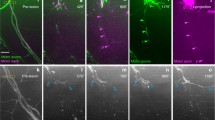Summary
Servered distal stumps of limb motor axons in the crayfish Procambarus clarkii remain ultrastructurally intact for at least 2–3 ms after being severed from their cell body. Initial regeneration of a motor axon is associated with the appearance of up to 200 small profiles (satellite axons) having no glial sheath adjacent to the large surviving stump for about 1 cm distal to the lesion at 4–5 wks postoperatively. These satellite axons are seen 2–4 cm distally at the target muscles 3–4 ms postoperatively. By 14–15 ms postoperative, the motor sheaths from the lesion site to the target muscles contain small axonal processes having thick glial sheaths. Behavioral tests show that some axons that are reconnected to the CNS at 4–5 wks may not be connected at 14–15 ms, whereas other axons not connected by 3–4 ms may be connected at 14–15 ms when the original distal stumps have degenerated.
We suggest that all these data can best be explained by the view that motor axons in crayfish limbs initially regenerate via activation of the surviving distal stump by satellite axons which grow out from proximal stump. In most cases, these satellite axons continue to activate the surviving distal stump as they slowly grow to the target muscle. Eventually the satellite axons reform synapses on the target muscle and the original distal stump degenerates.
Similar content being viewed by others
References
Atwood HL, Govind CK, Bittner GD (1973) Ultrastructure of nerve terminals and muscle fibers in denervated crayfish muscle. Z Zellforsch 146:155–165
Ballinger ML, Bittner GD (1980) Ultrastructural studies of severed medial giant and other CNS axons in crayfish. Cell Tissue Res 208:123–133
Bennett MVL (1977) Electrical transmission: a functional analysis and comparison to chemical transmission. In: Geiger SR (ed) Handbook of Physiology. Amer Physiol Soc, Maryland, pp 379–382
Birse SC, Bittner GD (1976) Regeneration of giant axons in earthworms. Brain Res 113:575–581
Birse SC, Bittner GD (1981) Regeneration of earthworm giant axons following transaction or ablation. J Neurophysiol 45:724–742
Bittner GD (1973a) Degeneration and regeneration in crustacean neuromuscular systems. Am Zool 13:379–408
Bittner GD (1973b) Trophic dependence of fiber diameter in a crustacean muscle. Exp Neurol 41:38–53
Bittner GD (1977) Trophic interactions of crustacean neurons. In: Hoyle G (ed) Identified Neurons and Behavior. Plenum Press, NY, pp 507–532
Bittner GD, Johnson AL (1974) Degeneration and regeneration in crustacean peripheral nerves. J Comp Physiol 89:1–21
Bittner GD, Ballinger ML (1980) Ultrastructural changes at gap junctions between lesioned crayfish axons. Cell Tissue Res 207:143–153
Bittner GD, Ballinger ML, Larimer JL (1974) Crayfish CNS: Minimal degenerative and regenerative changes after lesioning. 189:13–36
Bodenstein D (1957) Studies on nerve regeneraton in Periplaneta americana. J Exp Zool 136:89–115
Boone LP, Bittner GD (1974) Morphological and physiological measures of trophic dependence in a crustacean muscle. J Comp Physiol 89:123–144
Cantino D, Mugnaini E (1975) The structural basis for electrotonic coupling in the avian ciliary ganglion. A study with thin sectioning and freeze-fracturing. J Neurocytol 4:505–536
Carbonetto S, Muller KJ (1977) A regenerating neuron in the leech can form an electrical synapse on its severed axon segment. Nature 267:450–452
Guthrie D (1967) Regeneration of motor axons in an insect. J Insect Physiol 13:1593–1611
Hill RH, Lang F (1979) A revision of the inhibitory innervation pattern of the thoracic limbs of crayfish and lobster. J Exp Zool 208:129–135
Hoy RR, Bittner GD, Kennedy D (1967) Regeneration in crustacean motoneurons: Evidence for axonal fusion. Sci 156:251–252
Jacklet JW, Cohen MJ (1967) Nerve regeneration: Correlation of electrical, histological, and behavioral events. Sci 156:1640–1643
Kennedy D, Bittner GD (1974) Ultrastructural carrelates of motor nerve regeneration in crayfish. Cell Tissue Res 148:97–110
Korn H, Faber DS (1975) An electrically mediated inhibition in goldfish medulla. J Neurophysiol 38:452–471
Martin AR, Pilar G (1963) Dual mode of synaptic transmission in the avian ciliary ganglion. J Physiol 168:443–463
Muller KJ, Carbonetto S (1979) The morphological and physiological properties of a regenerating synapse in the CNS of the leech. J Comp Neurol 185:485–516
Nordlander RH, Singer M (1972) Electron microscopy of severed motor fibers in the crayfish. Z Zellforsch 126:157–181
Nordlander RH, Singer M (1973) Degeneration and regeneration of severed crayfish sensory fibers: an ulrastructural study. J Comp Neurol 152:175–192
Nordlander RH, Singer M (1976) Synaptoid profiles in regenerating crustacean peripheral nerves. Cell Tissue Res 166:445–460
Pearson KG, Bradley AB (1972) Specific regeneration of excitatory motoneurons to leg muscles in the cockroach. Brain Res 47:492–496
Ramón y Cajal S (1928) RM Macy (trans.) Degeneration and regeneration of the nervous system. Univ Press, London
Sherman RH, Atwood HL (1971) Structure and physiology of a newly discovered muscle in the walking legs of the lobster Homarus americanus. J Exp Zool 176:461–474
Wiersma CAG, Ripley SH (1952) Innervation patterns of crustacean limbs. Comparata Et Oecol 2:391
Author information
Authors and Affiliations
Additional information
This work was supported by NSF grants BNS 77-27678 and 80-22248 and an NIH RCDA 00070 to GDB. The authors would like to thank Mr. Martis Ballinger, Mr. Robert Reiss, and Mrs. Mary Raymond for their excellent technical assistance. We would also like to thank Dr. Wesley Thompson and Mr. Douglas Baxter for helpful discussions.
Rights and permissions
About this article
Cite this article
Bouton, M.S., Bittner, G.D. Regeneration of motor axons in crayfish limbs: Distal stump activation followed by synaptic reformation. Cell Tissue Res. 219, 379–392 (1981). https://doi.org/10.1007/BF00210156
Received:
Issue Date:
DOI: https://doi.org/10.1007/BF00210156




